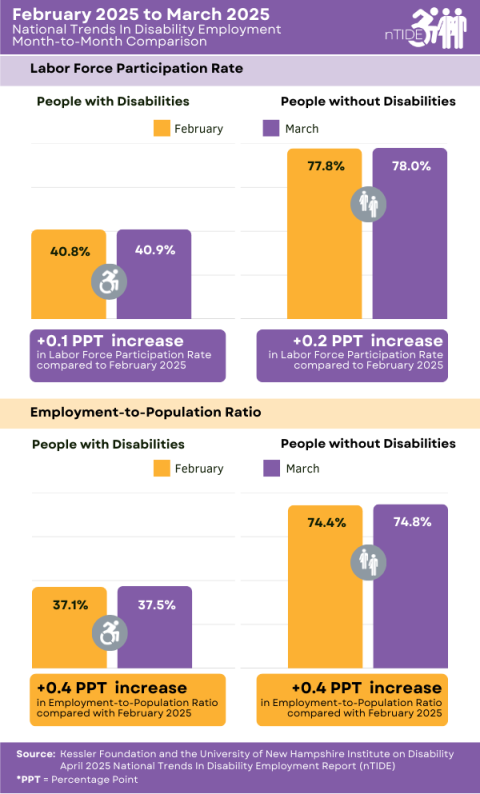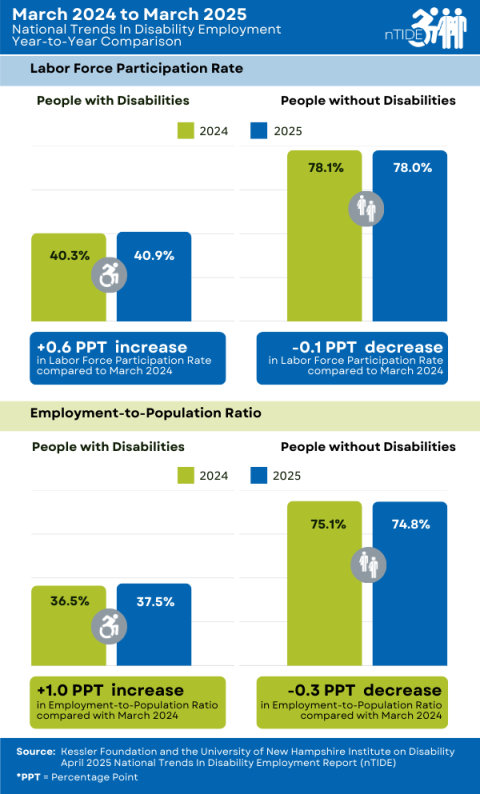
Join us for the next nTIDE Lunch & Learn Webinar featuring guest presenters Lindsay DuBois and Dorothy Hiersteiner of Human Services Research Institute (HSRI).
nTIDE April 4, 2025 Jobs Report: Modest Gains Reflect Ongoing Stability in Disability Employment and a ‘New Normal’
National Trends in Disability Employment (nTIDE) – Issued monthly by Kessler Foundation and the University of New Hampshire
Durham, NH – April 4, 2024 – The latest National Trends in Disability Employment (nTIDE) report revealed employment indicators for people with disabilities showing a modest gain in March, with the employment-to-population ratio rising by 0.4 percentage points. While not a dramatic increase, and still well below historic highs, this marks continued stability in labor market engagement for people with disabilities. Labor force participation also saw a slight gain, holding steady near 38 percent—a level that has become the new normal over the past 12 to 18 months. nTIDE is issued by Kessler Foundation and the University of New Hampshire’s Institute on Disability.
Month-to-Month nTIDE Numbers (comparing February 2025 to March 2025)
Based on data from the U.S. Bureau of Labor Statistics (BLS) Jobs Report released today, the employment-to-population ratio for people with disabilities (ages 16-64) increased from 37.1 percent in February 2025 to 37.5 percent in March 2025 (up 1.1 percent or 0.4 percentage points). For people without disabilities (ages 16-64), the employment-to-population ratio increased from 74.4 percent in February 2025 to 74.8 percent in March 2025 (up 0.5 percent or 0.4 percentage points). The employment-to-population ratio, a key indicator, reflects the percentage of people who are working relative to the total population (the number of people working divided by the number of people in the total population multiplied by 100).

From February 2025 to March 2025, the employment-to-population increased from 37.1 percent to 37.5 percent ratio for people with disabilities and increased from 74.4 percent to 74.8 percent ratio for people without disabilities. The labor force participation rate increased from 40.8 percent to 40.9 percent for people with disabilities and increased from 77.8 percent to 78.0 percent for people without disabilities.
“The employment-to-population ratio for people with disabilities increased slightly last month going from 37.1 percent in February to 37.5 percent in March,” remarked John O’Neill, PhD, director of the Center for Employment and Disability Research at Kessler Foundation. “But this period of relative stability in employment for people with disabilities may not last. We are beginning to see layoffs among public sector workers and government contractors as efforts to reduce the size of the federal workforce take effect. At the same time, post-COVID recovery funds distributed to states and municipalities are winding down, which could further impact employment opportunities,” he added.
Meanwhile, the labor force participation rate for people with disabilities (ages 16-64) increased slightly from 40.8 percent in February 2025 to 40.9 percent in March 2025 (up 0.2 percent or 0.1 percentage points). For people without disabilities (ages 16-64), the labor force participation rate increased from 77.8 percent in February 2025 to 78.0 percent in March 2025 (up 0.3 percent or 0.2 percentage points). The labor force participation rate is the percentage of the population that is working or actively looking for work (the number of people in the labor force divided by the number of people in the total population multiplied by 100).
“The labor force participation rate of people with disabilities has reached a plateau, hovering near 38 percent over the past 12 to 18 months. The gains from the post-COVID employment expansion appear to be over,” said Andrew Houtenville, PhD, professor of economics and director of the UNH-IOD. “The labor force participation rate may increase for people with disabilities in the coming months as individual families seek to boost income due to anticipated increases in unemployment and prices,” he added.
Year-to-Year nTIDE Numbers (comparing March 2024 to March 2025)
When compared to the same month last year, the employment-to-population ratio for people with disabilities increased from 36.5 percent in March 2024 to 37.5 percent in March 2025 (up 2.7 percent or 1 percentage point). For people without disabilities, the employment-to-population ratio decreased from 75.1 percent in March 2024 to 74.8 percent in March 2025 (down 0.4 percent or 0.3 percentage points).

From March 2024 to March 2025, the employment-to-population ratio increased from 36.5 percent to 37.5 percent for people with disabilities and decreased from 75.1 percent to 74.8 percent for people without disabilities. The labor force participation rate increased from 40.3 percent to 40.9 percent for people with disabilities and decreased from 78.1 percent to 78 percent for people without disabilities.
Ask Questions about Disability and Employment
Each nTIDE release is followed by an nTIDE Lunch & Learn online webinar. This live broadcast, hosted via Zoom Webinar, offers attendees Q&A on the latest nTIDE findings, provides news, updates from the field, and features invited panelists who discuss current disability-related findings and events.
On April 4, 2025, at 12:00 pm – 1:00 pm Eastern, guest presenters Lindsay DuBois and Dorothy Hiersteiner, Human Services Research Institute, join Drs. O’Neill, Houtenville, and Denise Rozell, AUCD. Join our free Lunch & Learn live or visit the nTIDE archives at: ResearchonDisability.org/nTIDE.
